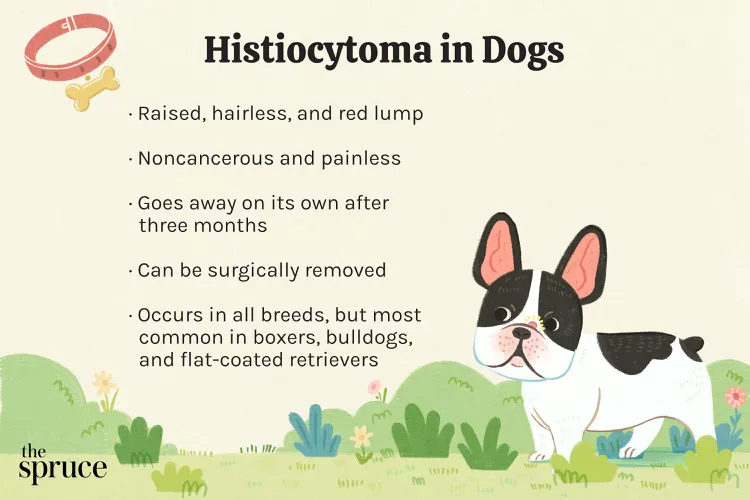Histiocytomas in Dogs

Histiocytomas look scary but they are not dangerous. Raised, red, and sometimes ulcerated, these benign growths are not usually painful or itchy for dogs. Surgical treatment is only recommended if the bump grows large enough to bother the dog or the owner. There are similar bumps that can indicate parasites or malignancy, though, so a veterinary exam is recommended to verify the type of growth on your dog's skin.
What Is a Histiocytoma?
A histiocytoma is a type of benign (non-cancerous) skin growth typically seen in young dogs. They originate in the Langerhans cells (also called histiocytes), which help protect a dog's body from foreign "invaders" on the skin such as pollen, bacteria, or fungi.
Symptoms of Histiocytomas in Dogs
Histiocytomas most commonly occur in dogs three years of age and younger. They generally appear suddenly and are discovered by chance when owners are petting their dogs. Because histiocytomas cause little or no irritation, dogs generally will not alert owners to them by scratching, licking, or chewing.
These growths are raised and usually smooth-surfaced, giving them a button-like appearance. They typically appear on the head, neck, ears, or limbs of a dog but can occur elsewhere on a dog's body. They can be as large as four centimeters in diameter but tend to be less than two centimeters.
What Causes Histiocytomas in Dogs?
Histiocytomas can occur in any breed of dog, but some breeds that they are more commonly seen in include boxers, bulldogs, and flat-coated retrievers.
While histiocytomas themselves are non-cancerous, on a microscopic level, they belong to a broader classification of growths known as round-cell tumors. There is no known cause for these tumors, some of which can become cancerous.
How Do Vets Diagnose Histiocytomas in Dogs?
If your dog suddenly develops a lump, or you suspect your dog may have a histiocytoma, your veterinarian will start by performing a thorough exam and obtaining a history of your dog.
As with all growths, definitive diagnoses of the type of growth are done by looking at the cells microscopically. This is accomplished either by surgically removing the growth and biopsying it or performing something called a fine needle aspirate, or FNA. An FNA is performed by collecting cells from the growth on a needle and then transferring them to a slide to look at under the microscope. It is minimally invasive and can be done on the same day as your initial exam for the growth.
If the growth is located in an area that would make aspirating or biopsying difficult and there is a high suspicion of a histiocytoma, your vet may opt to wait on performing any diagnostics and watch the lump to see if it remains stable or resolves on its own.
How to Treat Histiocytomas
Once your vet has definitively diagnosed your dog's lump as a histiocytoma, you can discuss removal options. Your vet may recommend waiting to see what the growth looks like in a few weeks or months. It is not uncommon for histiocytomas to resolve on their own.
Although these types of growths are rarely painful or irritating to a dog, it is important to prevent dogs from licking, chewing, or scratching, which may create secondary infections.
If the growth does not disappear, your vet may recommend removal via cryosurgery. This involves a local anesthetic to the area to freeze the growth. If your dog's histiocytoma is large, then cryosurgery may not be possible, so surgical removal will be the best option.
Prognosis for Dogs With Histiocytomas
If your dog has a histiocytoma surgically removed, as with all post-surgery care, it is of the utmost importance to prevent your dog from licking, chewing, or scratching at the incision to prevent him/her from opening up the incision and/or creating a secondary infection. Your vet will provide specific post-surgery instructions to keep the incision area clean.
If you notice any significant redness, swelling, or missing stitches, or if the incision feels warmer than the surrounding tissue, be sure to notify your vet immediately.
Dogs generally recover quickly from this minor surgery and suffer no long-lasting effects from the procedure. Dogs with small, painless histiocytomas may live happily with these benign growths for many years—no surgery required.
How to Prevent Histiocytomas
Because histiocytomas have no identifiable cause, there is no way to prevent them from growing. They are not contagious, though, and cannot be spread through skin-to-skin contact. They do not pose any threat to any humans or any other animals that your dog may come into contact with.